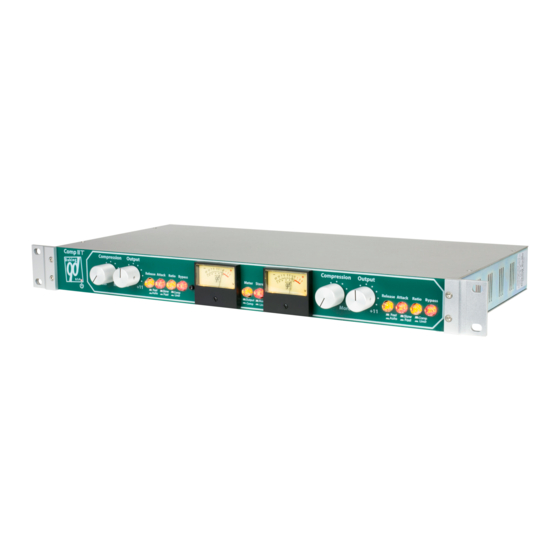
Advertisement
Quick Links
Advertisement

Summary of Contents for Daking Audio Comp IIT
- Page 1 Comp IIT Compressor-Limiter User Manual V.1 http://www.daking.com/...
-
Page 2: Safety Considerations
Safety Considerations • Read, follow and keep these instructions. • Heed all warnings. Install in accordance with the manufacturer’s instructions. • Protect device from liquids and spills. • Clean only with a soft, dry cloth • Do not block any ventilation openings. •... - Page 3 1.0 About Daking Audio Congratulations! You’ve purchased a Comp IIT, a very high-end piece of gear! The Comp IIT uses discrete transistor Class A circuits, VCAs, Jensen input and output transformers and printed circuit board-mounted switches. Signal capacitors are precision polypropylene or ultra low-leakage electrolytic types.
- Page 4 - they are mostly feed-forward designs utilizing cheap RMS detector chips and low-quality monolithic current-to-voltage convertors. The Comp IIT is a very different, more complex VCA design that uses feedback, a peak detector and an all-discrete Class A follower. We use the VCA like a FET to get the sound we all love without the thermal instability and other problems associated with FETS.
- Page 5 That means there cannot be a ground loop between what comes before the transformer and what comes after. In a piece of gear like the Daking Comp IIT with input and output transformers there cannot be ground hum or noise in a correctly wired system induced into the Comp IIT.
- Page 6 1.4 Front Panel Compression Knob The Compression knob controls how much you compress the signal, from Less to More. What is happening is that as you turn the control towards More you are lowering the threshold at which compression begins. The lower the threshold the more you compress a given signal.
- Page 7 Attack Attack controls the speed at which the Comp IIT responds to peaks in the signal. Slow allows transients to go through uncompressed but reduces the gain of what follows. Fast grabs the transients as well as the sustain of the signal.
- Page 8 In Link mode you must still set the front panel controls for both channels - in most cases they would be set the same. This is how you would use the Comp IIT on a stereo mix, for instance.
-
Page 9: Back Panel
XLR cable and a 1/4” TS cable at the same time keep in mind you will be making the XLR output unbalanced because they are in parallel. Always use high-quality connectors and cables to wire your Comp IIT into your system. Wiring is not the place to skimp. -
Page 10: Specifications
1.6 Specifications • Jensen input and output transformers • Class "A" amplifier for Gain Make-Up • All-metal construction with stainless steel chassis for noise immunity • Custom aluminum knobs • Power supply included • Frequency response: 20Hz - 65kHz • Inputs: 2 x XLR •... - Page 11 1.7 Appendix I Graph showing Comp IIT ratio response in Comp mode, Limit mode, and Bypass:...

Need help?
Do you have a question about the Comp IIT and is the answer not in the manual?
Questions and answers